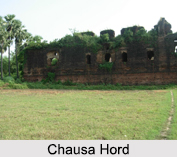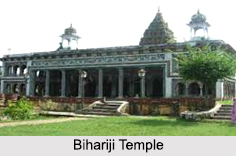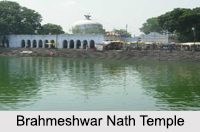 Buxar is a city on the bank of the River Ganges in the state of Bihar in India. It is the administrative headquarters of the Buxar District. A road bridge over Ganges links Buxar with Balia District in the adjoining state of Uttar Pradesh. The town is 125 km from the state capital Patna. Bhojpuri is the local language of Buxar.
Buxar is a city on the bank of the River Ganges in the state of Bihar in India. It is the administrative headquarters of the Buxar District. A road bridge over Ganges links Buxar with Balia District in the adjoining state of Uttar Pradesh. The town is 125 km from the state capital Patna. Bhojpuri is the local language of Buxar.
Etymology of Buxar
The word "Buxar" is said to have been derived from "Vyaghrasar". The tiger face of Rishi Vedshira, an outcome of the curse of the sage Rishi Durvasa, was restored after bathing in a holy tank which was later named as "Vyaghrasar".
Historical Significance of Buxar
The famous "Battle of Buxar" was fought in this town. History reveals that Mir Qasim made an endeavour to recover Bengal from the hands of the British. In 1764, he sought the help of the Mughal Emperor Shah Alam II and Nawab Shuja-Ud-Daulah of Oudh (Awadh). On October 23, 1764, the British Major Hector Monroe, who headed a group of 857 European soldiers and 6213 sepoys, overpowered Mir Qasim along with his army at the "Battle of Buxar". This victory firmly planted the roots of the British Empire in India.
Geography of Buxar
Buxar lies on the border with the neighboring state of Uttar Pradesh, stretching over an area of 1703 square kilometers. River Ganga forms the border in north and in the west River Karmanasa.
 Mythological Significance of Buxar
Mythological Significance of Buxar
In Hindu religious literature, Buxar is believed to be referenced as "Siddhashram", "Vedgarbhapuri", "Karush", "Tapovan", "Chaitrath" and "Vyaghrasar". Some claim that the history of Buxar dates back even before the period of Ramayana. It is also believed that Ahilya, the wife of Gautam Rishi restored her human body from that of stone and got salvation by a mere touch of the feet of Lord Rama. Hence, this place is also known as Ahirauli.
Demography of Buxar
According to the 2011 India census, Buxar had a population of 102,861. Males make up 52.65% of the population and females 47.35%. Buxar has an average literacy rate of 79.77%, which is higher than the national literacy rate of 59.5% with male literacy of 87% and female literacy of 65%. 16% of the population is under 6 years of age.
Agriculture of Buxar
Agriculture is the main occupation of the majority of the people of this district. The region is considered to be the best wheat growing area in the State and India. The farmers are engaged in growing rice, wheat, sugarcane, potato, jowar, bajra, maize, sunflower and all varieties of green vegetables. Buxar is abundant with mangotrees.
 Tourism in Buxar
Tourism in Buxar
There are several tourist places in Buxar, which are Buxar Fort, Brahmeshwar Nath Temple, Katkauli Ka Maidan, Chausa Hord, Sita Ram Upadhyaya Museum, Bihariji Temple, Naulakha Mandir, Ahilya Uddhar, Ram Rekha Ghat, Raj Bhoj Fort, Siddhashram. Some of the places have been detailed below:
Buxar Fort: Buxar Fort is one of the ancient structures of Buxar district. It was built by King Rudra Deo in the year 1054 A.D along the Ganges River. Gauri Shankar Temple and Nath Baba Temple are some of the famous temples inside the fort complex.
Brahmeshwar Nath Temple: Dedicated to Lord Shiva, this temple is situated at a distance of 2 km from Raghunathpur. During Shiva Ratri, the main festival of this temple, devotees flock to this temple to offer their prayers to the God.
Bihariji Temple: This temple is located at a distance of 15 km from the main city. It is dedicated to Lord Krishna, whose another popular name is Bihari. The temple was constructed by the erstwhile king of Dumraon estate, Jaiprakash Singh in the year 1825.
Ahilya Uddhar: This ashram is 3km from Buxar; it is famous for Rishi Gautam. This silent ashram is the best place for meditation.
Sita Ram Upadhyaya Museum: This Museum was established in 1979 for preserving rare stone sculptures and coins. It has been named after late Sita Ram Upadhyaya, who collected a contrasting range of terracottas. There is a separate gallery in the museum that presents his unique collection.
Chausa Hoard: On this ancient site, the first-time bronze hoard was discovered. The hoard was a set of 18 Jain bronzes that housed articles dating back to Gupta period. This site is also famous for the historic war between Mughal Emperor, Humayun and Sher Shah in 1539 AD. In this war Sher Shah defeated Humayun. This destination is also popular for the Chausa Mangoes.
Katkauli Ka Maidan: This site has great historical significance as it had witnessed the "Buxar Battle" in 1764 between British East India Company and Mir Quasim.
Visiting Information to Buxar
Buxar Railway Station and Patna airport are the nearest to this place. It can also be reached by road via National Highway 19.



















